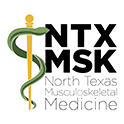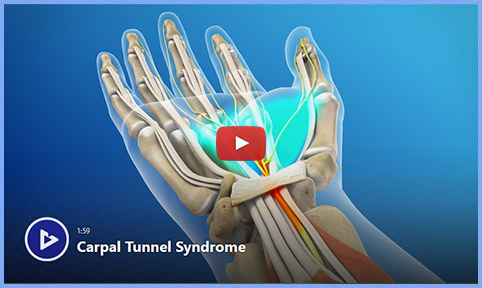HAND & WRIST CONDITIONS
The wrist is made up of eight small bones called carpals that are arranged in two rows. The synovial joints between the carpal bones themselves and the joints between the carpals and the wrist are covered with articular cartilage that allows for ease of movement. Wearing or injury to this cartilage often results in arthritis.
Six major ligaments give stability to the wrist by joining the carpal bones to the bones in the wrist. Other ligaments bind the two rows of carpal bones together. When the carpal ligaments become damaged from overuse or injury, the tunnel encasing the tendons and nerves becomes irritated and inflamed.
The tendons connecting the muscles to the bones in the wrist run down our fingers and are held in place by a series of ligaments called "pulleys" that cross over the tendons forming a tunnel-like sheath. In healthy joints, these tendons glide easily through the tunnel. Repetitive use or injury can cause inflammation and pain, preventing this complex structure from working as it should. Pressure on the median nerve causes pain, numbness and tingling of the carpal tunnel. Surgery should not be the first option for this condition. Natural orthobiologic procedures can help to heal the damaged tissue so the wrist and hand can function smoothly.
Treatment Options
Osteopathic Manipulative Medicine focuses on correcting mechanical dysfunction. Structural integrity allows these complex joints to function as they were designed, reducing irritation, inflammation and pain. Healthy function improves blood flow to nourish tissue and further reduce inflammation. Strain on surrounding body tissue caused by compensation is reduced preventing further complications.
Platelet Rich Plasma Therapy (PRP) promotes and accelerates the natural healing process of tissue injury and osteoarthritis. PRP accelerates re-growth of healthy tissue, stabilizing and strengthening the joint. Condensed platelet injected into damaged tissue stimulates the release of mesenchymal stem cells residing in local tissue. The concentrated solution of platelets and plasma contain healing cells, alpha-granules, result in new cell growth and increased blood flow.
Benefits of Regenerative Medicine
Natural Healing:
Regenerative Medicine treatments harness the body's innate healing mechanisms, promoting long-term recovery rather than temporary symptom relief.
Enhanced Tissue Repair:
Regenerative Medicine aims to repair and regenerate damaged tissues, potentially restoring function and reducing the need for more invasive treatments.
Reduced Risk of Side Effects:
Unlike corticosteroids, regenerative therapies generally have fewer and less severe side effects, as they use natural substances from the patient's own body.The Promise of Regenerative Medicine
What are Regenerative Medicine Procedures?
Regenerative medicine offers a transformative approach to treating musculoskeletal conditions by harnessing the body's natural healing capabilities.
- Platelet-Rich Plasma (PRP): PRP therapy involves extracting a small amount of the patient's blood, processing it to concentrate the platelets, and injecting this platelet-rich plasma into the injured area. PRP is rich in growth factors that promote tissue repair and regeneration.
- Bone Marrow Aspirate Concentrate (BMAC), commonly known as Stem Cell Therapy: BMAC uses the patient's own stem cells, typically harvested from bone marrow or adipose tissue, to promote healing. These stem cells can differentiate into various types of cells needed for repair, such as cartilage or tendon cells.
- Prolotherapy: Prolotherapy involves injecting a solution, often containing dextrose, into the damaged area. This solution irritates the tissue, triggering the body's natural healing response and promoting the repair of ligaments and tendons.
Regenerative procedures are designed to help reduce knee pain and improve function with precise
highly specific image-guided medical procedures.
Pain, numbness and tingling in your hand may be from carpal tunnel syndrome. The small space in your wrist where the median nerve passes, the carpal tunnel, becomes too tight. This condition is often caused when the carpal ligaments that form this tunnel become damaged and inflammed from overuse. This condition can be treated nonsurgically using PRP injections to help heal these ligaments and reduce inflammation and when the carpal ligaments that form this tunnel become damaged and inflammed from overuse. This condition can be treated nonsurgically using PRP injections to help heal these ligaments and reduce inflammation and pain.
To determine if Regenerative Orthopedics will be helpful for you, please tell us about your condition.
Common hand and wrist conditions
Carpal tunnel syndrome. Repetitive motion can damage the transverse carpal ligaments supporting the tunnel containing the tendons and nerves. It is generally characterized by numbness or pain in the thumb and first 2 fingers and occurs when the median nerve is compressed at the wrist. Carpal tunnel syndrome is often a common complaint in individuals who use their hands for prolonged periods of time in a particular occupation such as computer work. Nonsurgical orthobiologic procedures treat damage to the ligaments, reducing inflammation and allowing the tendons to flow smoothly through the tunnel created by the carpal ligaments. Healthy functio is restored to the wrist and hand.
Arthritis. The joints between the carpal bones and the wrist are covered with articular cartilage that allows for ease of movement. When this tissue becomes damaged from overuse or injury, friction between the bones creates inflammation and pain. Excess bone can develop. Basal joint osteoarthritis occurs at the base of the thumb and is generally associated with aging.
Sprains and strains. Sprains and strains are the two most common injuries affecting the hand and wrist. A sprain refers to an injury to a ligament and a strain refers to an injury to a muscle or tendon. Sprains and strains occur due to excessive force applied during a stretching, twisting, or thrusting action.
Ligamentous injuries. Ligaments are tissues that connect bones to other bones. They are made up of several fibers and one or all of the fibers may be involved. A ligament injury may cause pain and swelling and limit the movement of hand and wrist joints.
Other common hand and wrist conditions include: De Quervain's Tenosynovitis. Tendinitis, Trigger finger
Understanding the Risks of High-Dose Corticosteroid Injections
The management of pain and inflammation is a critical aspect of patient care in musculoskeletal medicine. High-dose corticosteroid injections have been a mainstay treatment for various conditions such as arthritis, tendonitis, and bursitis. However, while these injections can provide rapid relief, they are not without significant risks. Learn more about the negative effects of cortisone in Dr. Minotti's blog.
The Downside of High-Dose Corticosteroid Injections
Corticosteroid injections work by reducing inflammation, thereby alleviating pain. However, the use of high-dose corticosteroids comes with several potential adverse effects:
- Joint and Tissue Damage: Repeated corticosteroid injections can lead to the weakening of tendons, cartilage, and bone. This can result in joint instability and an increased risk of tendon ruptures.
- Osteoporosis: High doses of corticosteroids can accelerate bone loss, increasing the risk of fractures and osteoporosis.
- Infection Risk: Corticosteroid Injections can suppress the immune system, potentially leading to infections such as septic arthritis.
- Endocrine Disruption: Corticosteroids can interfere with the normal function of the adrenal glands, potentially causing hormonal imbalances and conditions such as Cushing's syndrome.
- Short-Term Relief: While corticosteroids can provide rapid pain relief, this effect is often temporary, necessitating repeated injections and increasing the risk of cumulative damage.
We Can Help
To learn more about what we can do to help with your condition, call our office at 817-416-0970. We will thoroughly diagnose your condition and present you with treatment options. From there we will guide you along your road to recovery.

